Urk, Province of Flevoland, Netherlands 作者: 来源: 发布时间:2021-02-21
一、人口,面积,所属地区
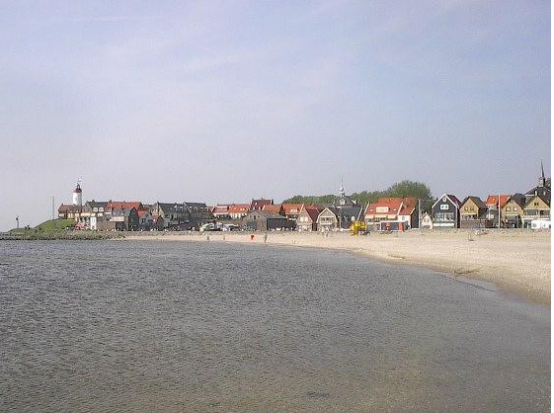
Location in Flevoland
Country Netherlands
Province Flevoland
Government
Body Municipal council
Mayor Ineke Bakker
Area
Total 109.91 km2 (42.44 sq mi)
Land 11.53 km2 (4.45 sq mi)
Water 98.38 km2 (37.98 sq mi)
Population (January 2019)[4]
Total 20,776
Density 1,802/km2 (4,670/sq mi)
Demonym(s) Urker
Area code 0527
Website www.urk.nl
Urk is a municipality and a town in the Flevoland province in the central Netherlands.
Urk is first mentioned in historical records dating to the 10th century, when it was still an island in the IJsselmeer, a lake that would become part of the Zuiderzee in the 13th century after a series of incursions by the North Sea. In 1939, a dike from the mainland to Urk ended the town's island status, just as the Afsluitdijk project was changing the salt water Zuiderzee surrounding Urk to the less saline IJsselmeer. Later in the 20th century, seabed areas surrounding Urk were reclaimed from the sea and became the Noordoostpolder.
The mainstay of the town's economy has always been fishing, and the products of the sea coming in through Urk's harbour continue to be exported widely, although today Urk's fishing boats must travel greater distances to gather them than was required in most historical periods. Religious life has also traditionally been very important to Urk's inhabitants, with active, conservative congregations of the Dutch Reformed denominations playing key roles in the life of the community.
二、自然地理
Around the IJsselmeer is an arc of boulder clay high areas of land, which formed during the Ice Age glaciations of the Pleistocene epoch: Texel, Wieringen, Urk, de Voorst, and Gaasterland. To south of that arc, as a result of meltwater, a lake formed, which became known as Almere. North of the boulder clay highland of Urk, the Vecht river flowed into the Almere, while the river IJssel with tributaries flowed into the south of Urk. As the climate became warmer during the Middle Ages, the sea level rose; and since the Ice Age ended the Netherlands and around have been slowly steadily sinking because of forebulge effect. During the 13th century (and especially after a large storm in 1282) the Zuiderzee formed, and the water round Urk suddenly became tidal sea. Because there was no sea defence, in the course of time large pieces of the island were eroded away. The southwest side of Urk, which rose perpendicularly out of the sea, was called het Hoge Klif ("the High Cliff"). Around 1700 the municipality of Amsterdam gave sea defences to Urk. The town contains the highest point in the province of Flevoland.

Demographics
Year 2007:
Birth Rate: 22.23 per 1000
Death Rate: 3.24 per 1000
NGR: +1.90% per year.
The birth rate of the municipality of Urk is the highest in the Netherlands as of 2016 (and highest in previous years). But like many other places in the Netherlands this number declined to 18,7‰ (down from 30,8‰ in 1988). In 1988 only Zeewolde had a slightly higher birth rate at 31,3‰, but the birth rate Urk remained the second highest. The total fertility rate declined to 2,6 (down from 3,9 in 1988).
三、经济发展和规模
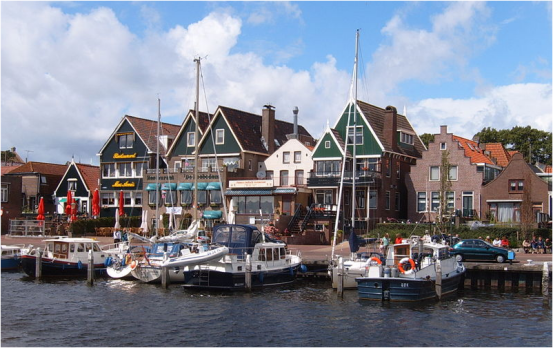
The quay of Urk
The important economic pillar of the village is the fishery. After the IJsselmeer was formed, the Urkers fished on the North Sea. Due to rising prices of fish, at present Urk is a very prosperous village. In the past, many lives were lost in storms on the Zuiderzee and North Sea. There is a memorial to lost fishermen on Urk, popularly known as the Urker vrouw: a statue of a woman looking out to sea, vainly awaiting the return of her husband and sons.
Urk is a municipality and a town in the Flevoland province in the central Netherlands. Urk is first ... 2010) a Dutch author of detective fiction and police officer; Erwin Straatsma (1935 in Urk – 2007) a Dutch entrepreneur in the tobacco industry
Local development plans
The economic plans of the Town of Urk is directed towards balancing the labour force and job availability on the one hand and on the other diversification of employment while securing the strong position in the fishing sector on the other.
Urk is the fish centre of the Netherlands and the flatfish centre of Europe, according to the municipality. The municipality would like to keep both auction halls in the municipality and they feel the fish processing industry should be stimulated to add value to its products.
It still wants to diversify its local economy by stimulating starter enterprises (in other sectors than fish), by promoting Urk as a good place to situate an enterprise and to facilitate new and old businesses with good conditions.
Urk also intends to stimulate tourism, especially water tourism by upgrading the harbour, its environment, accommodations and catering.
In addition to tourism, Urk is stimulating shipbuilding and transport by water through improved harbour facilities.
四、产业特点/重点项目
Healthy Seas
Largest Dutch fishing fleet starts collecting nets for Healthy Seas
The Urk fishing community, the municipality of Urk, and Healthy Seas have today signed a cooperation agreement in Urk, the Netherlands. This agreement marks the start of cooperation to bring the old fishing nets from Urk into the Healthy Seas recycling process and so to ensure that as few nets as possible end up in the sea. It is a big step forward in building close cooperation with the fishing industry in the Netherlands.
With the help of divers and salvage companies, Healthy Seas removes ‘ghost nets’ from the sea – in the North Sea these are mainly a legacy of the last century – and works with fishing communities to recycle old fishing nets. Some of the nets are transformed into ECONYL®, a high-quality yarn. This yarn is used by various companies to manufacture clothing and carpets. The Dutch company Star Sock, one of the founders of Healthy Seas, makes socks from ECONYL® yarn.
Urk Visveiling
Activities> Fish Market
Activities> Seafood Activity (Industry Chain)
Urk Visveiling is an example,in the heart of the Netherlands has a strong market position within the European fishing industry. The nationally and internationally oriented, innovative company with professional vision, it is viscentrum of Europe and offers both the captain and the buyer many advantages.
On May 19, 1904 Urk Fish Auction was established for the marketing of fish from the former Zuiderzee. The land reclamation in the '30s had a profound effect on the Urk community because the salt water was sweet and fleet shifted to the North Sea. Through the vision, courage and perseverance of the fishermen was a very modern fleet of Urk Fish Auction created and developed in the years to the hub of the fishing industry. Urk Fish Auction was in terms of sales volume and the largest in the Netherlands and one of the largest in Europe.
Visveiling Urk was founded in 2008 by the merger between Urk auction and Harlingen.
Address: Westwal 2
Telephone: +31 0527 689789
Fax: +31 0527 - 689799
Email: info@visveilingurk.nl
五、风景名胜,景点
Ketelmeer
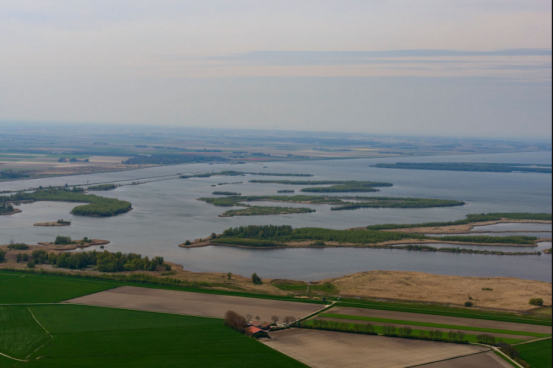
Type bordering lake
Basin countries Netherlands
Surface area 3,500 ha (8,600 acres)
Islands IJsseloog
The Ketelmeer is the tongue of the IJsselmeer into which the River IJssel drains, it is situated between the polders Noordoostpolder and Oostelijk Flevoland, and connects the river IJssel to the IJsselmeer. It is one of the bordering lakes, a continuous body of water which separate Flevoland from the Noordostpolder and the ancient lands of the provinces of Gelderland and Utrecht. The Ketelmeer covers an area of 3500 hectares, most of which is in the province of Flevoland, but the river delta of the IJssel is in province of Overijssel. It was carved out from the Zuiderzee by the construction of the polders of Noordoostpolder and Flevoland, between which it lies. It is via Ketelmeer that the IJsselmeer connects to the Zwarte Meer and the Veluwemeer, the strip of water which separates Flevoland from the coast of the mainland. The Ketelmeer contains the IJsseloog, a kilometre-diameter circular pit in an artificial island, built to contain the toxic sludge dredged from the bed of the Ketelmeer The Ketelbrug is a bascule bridge over the Ketelmeer connecting the Noordoostpolder and Oostelijk Flevoland.
Urk Lighthouse

Location Urk
Year first lit 1845
Construction brick tower
Tower shape tapered cylindrical tower with balcony and lantern
Markings / pattern White tower, black trim, red lantern with green dome
Tower height 18.5 metres (61 ft)
Focal height 27 metres (89 ft)
Original lens Fresnel lens
Range 18 nautical miles (33 km)
Characteristic Fl 5s
ARLHS number NET-026
Netherlands number 1956
Heritage Rijksmonument, Rijksmonument
Urk Lighthouse is a lighthouse in Urk at the eastern banks of the IJsselmeer. From 1617 a coal fire was used for the local fishermen as well as for the ships sailing from Amsterdam to the North Sea. The current lighthouse station was established in 1837. The tower was built in 1845 as a round brick tower attached to a keeper's house. A Fresnel lens is still in use. The lighthouse was restored in 1972 and declared a national monument of the Netherlands in 1982. The tower can be visited during guided tours.
Museum het Oude Raadhuis

Address: 2, Wijk 2, 8321 EP Urk, Netherlands
Phone: +31 527 683 262
Witte Zandvlakte
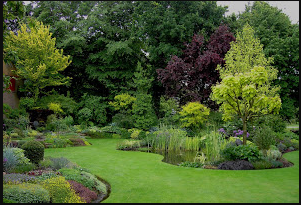
The state natural monument has an area of 18 hectares and consists of reed land, dune reed grassland and tree storage. Part of it was excavated in the fifties and sixties for sand extraction. A large pool with a lot of vegetation has now been created on that site. The banks of the lake are home to various plants, such as the large and small bulrush, sea rush and rough rush.
That the saline sedge is also growing in the state natural monument is something special, according to the minister.
After 1950, this species has hardly been spotted in the eastern IJsselmeer region. The beautiful centaury is also called rare. There are also many birds in the area, such as the reed warbler, reed bunting, reed warbler, garden warbler, chiffchaff, black headed, shoveler, water rail and bearded male. The thicket includes the warbler and fitis.
It is also worth noting, according to the minister, the breeding of the marsh harrier. It is essential for the area that the current water management and the existing peace are maintained. "Recreational shared use should be aimed at experiencing nature and education and should be regulated by zoning," said the minister, who expects the western section to be open to the public.
六、历史文化
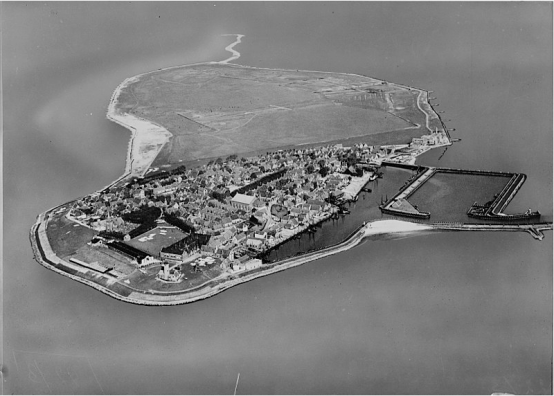
Urk Island (1852)
Aerial photograph of the former island Urk, before its integration in the Noordoostpolder, 1920–1940. Nederlands Instituut voor Militaire Historie.
The oldest instance of the name "Urk" is a donation certificate of 966 from Holy Roman Emperor Otto I to the Sint Pantaleonsklooster monastery in Cologne. The text reads: cuiisdam insulae medietatem in Almere, que Urch vocatur (Latin: "of a certain island in the middle of Almere, which is called Urch").
Until 1475 the High and Low Lordship of Urk and Emmeloord (the most northern village of Schokland) was in the hands of the Van Kuinre family.
From 1475 to 1614, the Zoudenbalch family of Utrecht were Lords of Urk and Emmeloord.
From 1614 to 1660, Urk and Emmeloord were ruled by Jonkheer van der Werve. (from an important family of Antwerp.)
From 1660 to 1792 Urk and Emmeloord belonged to the municipality of Amsterdam, and ruled from 1660 to 1672/1678 by Andries de Graeff.
From 1792 to 1950 Urk belonged to the province of Noordholland.
From 1950 to 1986 Urk belonged to the province of Overijssel.
Since 1986, Urk has belonged to the province of Flevoland.
After WWII, Urk's town spread into the polder. Many Urkers who had to leave the town because of overcrowding before the polder reclamation was completed were able to return to Urk.
The Noordoostpolder in its early years had an alternative name "Urker Land," from which Urk's newspaper, Het Urkerland, gets its name.
七、其他信息
Rail Links
Urk has no railway station but the nearest stations are Kampen, Dronten and Lelystad, each approximately 30 kilometres (19 miles) away. This makes Urk one of the most isolated places in the Netherlands as far as railway connections are concerned.
Folktales
Ommelebommelestien
A famous Urkish folktale is the story parents tell their children when they want to know where the babies come from. The tale involves a large exposed rock which can be seen in the IJsselmeer about 30 metres (98 feet) from the shore. This stone is known as the "Ommelebommelestien".
Urkers often tell their children that there are two kinds of people-- vreemden (strangers) and Urkers (people from Urk). Strangers are usually born from a cabbage, or a stork brings them to their new parents, but Urkers come from a large stone which lies about 30 metres (98 feet) from the shores of their former island. Nowadays, the stone is usually called "Ommelebommelestien" (Ommel-Bommel Stone), but in former times it was called "Ommelmoerstien": moer means "mother's" in the Urkish dialect.
In the tale, a stork comes all the way from Egypt to put babies in the stone. When the baby is about to be born, the baby's father is said to have to go to Schokland to pick up the key that gives access to the stone. So when an Urkish man is asked if he has been to Schokland, he is actually being asked if he has children.
In the older days, when both Urk and Schokland were still islands in the Zuiderzee, the father had to take the obstetrician in his boat and row from Urk to Schokland to get the key, and then from Schokland to the Ommelebommelestien to get the baby. Nowadays he would be able to go to Schokland by car, but according to the legend he still has to row. The door to the stone is somewhere below sea level, so it is difficult to find.
Once the door was found, a small price had to be paid for the baby: traditionally one Dutch guilder for a girl but two for a boy.
The mother was said to be kept in bed with a nail through her right foot. There she would celebrate that she had just become a mother
Urk and the arts
The prolific Dutch writer Albert Cornelis Baantjer was born here. Baantjer is mainly known for his large series of detective novels revolving around police inspector De Cock and his side-kick, sergeant Vledder.
Writer Jef Last lived on Urk for several years from 1932 onwards. He wrote several articles about Urk for one of the most progressive Dutch magazines, 'De Groene Amsterdammer'. While living here, he fell in love with a fisherman, and was inspired to write Zuiderzee. This novel deals with the love between two fishermen living on Urk and was one of the first, if not the first novel in Dutch literature to openly deal with homosexuality.
The Dutch writer, painter and resistance hero Willem Arondeus spent some time in Urk from 1920. While residing on Urk, during 1922, he wrote 'Afzijdige Strofen', a collection of twenty homo-erotic poems which were posthumously published in 2001.
八、联系方式
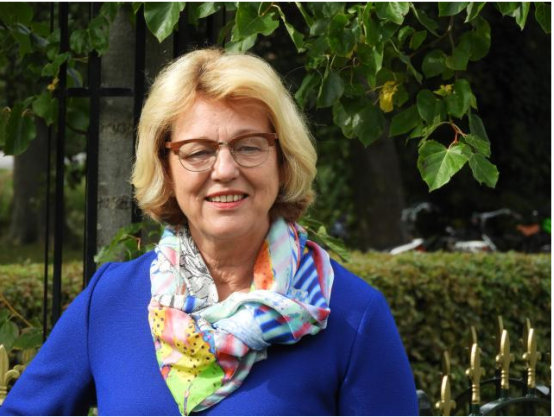
Mayor Ineke Bakker
Address
Singel 9, 8321 GT Urk
Box 77, 8320 AB Urk
Phone : 0527 - 68 98 68
WhatsApp : 06 - 13 56 79 71
Twitter: Gemeente Urk
@Gemeente_Urk
